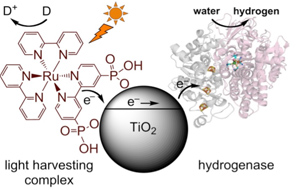Solar hydrogen production with an enzyme-nanoparticle hybrid system
Erwin Reisner, The University of Manchester, UK
| When |
06 Jul, 2010
from
02:30 pm to 03:30 pm |
|---|---|
| Where | Room 2.13 |
| Add event to your calendar |
|
Seminar
Title: Solar hydrogen production with an enzyme-nanoparticle hybrid system
Speaker: Erwin Reisner The University of Manchester, UK
Affiliation: School of Chemistry, The University of Manchester, UK
Host: Inês Cardoso Pereira
Abstract
Sunlight's electromagnetic and carbon-free energy can be used to generate hydrogen (H2) from water, but selective and economical chemical catalysts will be needed for this central chemical conversion. Enzymes known as hydrogenases catalyze the reversible reduction of protons into H2 with remarkable thermodynamic and kinetic efficiency at room temperature and neutral pH using iron- or nickel/iron active sites. A solar-light driven H2 production system containing a hydrogenase coupled to a ruthenium dye sensitized TiO2 nanoparticle (a key component of dye-sensitized solar cells) will be presented [1,2]. Detailed electrochemical studies have allowed to select a particularly suitable hydrogenase containing a [NiFeSe]-active site, which is able to (i) convert protons rapidly to H2 close to the thermodynamic potential at pH 7, (ii) produce H2 without being inhibited by accumulation of H2 and (iii) operate in the presence of trace amounts of O2 [3]. Importantly, this hydrogenase also binds strongly to the TiO2 surface in an electroactive configuration allowing for fast electron transfer to the active site via three [4Fe4S]-clusters [1]. This hybrid system is capable of producing H2 using visible light with an unprecedented rate of 50 (mol H2) per sec (per mol hydrogenase) from buffered neutral water at room temperature [2]. This work is supported by EPSRC (EP/H00338X).

References:
- E. Reisner, J.C. Fontecilla-Camps, F.A. Armstrong Chem. Commun. 2009, 550-552;
- E. Reisner, D.J. Powell, C. Cavazza, J.C. Fontecilla-Camps, F.A. Armstrong, J. Am. Chem. Soc. 2009, 131, 18457- 18466;
- A. Parkin, G. Goldet, C. Cavazza, J.C. Fontecilla-Camps, F.A. Armstrong J. Am. Chem. Soc. 2008, 130, 13410–13416.







